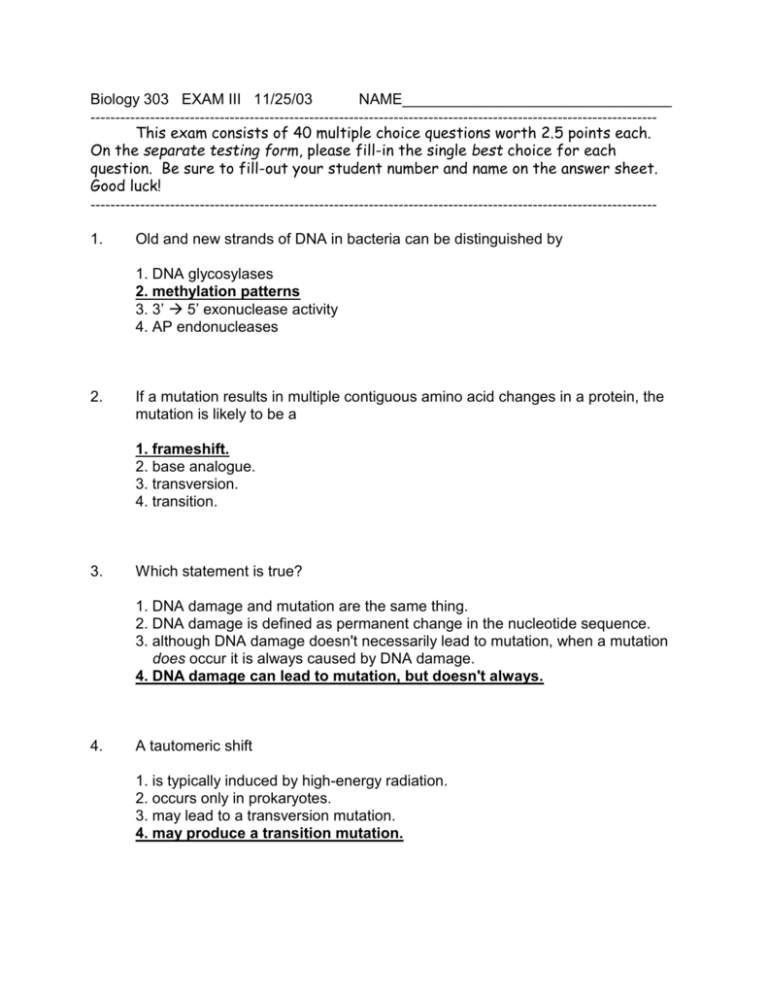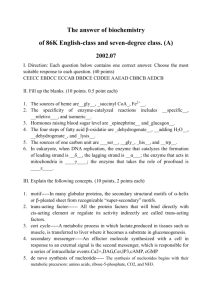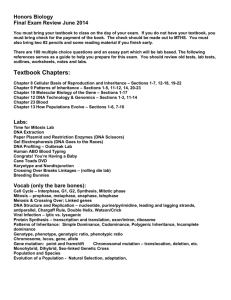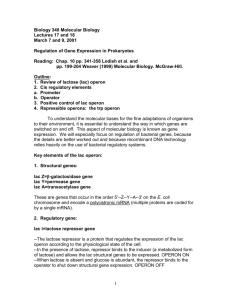Biology 303 EXAM II 3/14/00 NAME___________________________
advertisement

Biology 303 EXAM III 11/25/03 NAME________________________________ -----------------------------------------------------------------------------------------------------------------This exam consists of 40 multiple choice questions worth 2.5 points each. On the separate testing form, please fill-in the single best choice for each question. Be sure to fill-out your student number and name on the answer sheet. Good luck! -----------------------------------------------------------------------------------------------------------------1. Old and new strands of DNA in bacteria can be distinguished by 1. DNA glycosylases 2. methylation patterns 3. 3’ 5’ exonuclease activity 4. AP endonucleases 2. If a mutation results in multiple contiguous amino acid changes in a protein, the mutation is likely to be a 1. frameshift. 2. base analogue. 3. transversion. 4. transition. 3. Which statement is true? 1. DNA damage and mutation are the same thing. 2. DNA damage is defined as permanent change in the nucleotide sequence. 3. although DNA damage doesn't necessarily lead to mutation, when a mutation does occur it is always caused by DNA damage. 4. DNA damage can lead to mutation, but doesn't always. 4. A tautomeric shift 1. is typically induced by high-energy radiation. 2. occurs only in prokaryotes. 3. may lead to a transversion mutation. 4. may produce a transition mutation. 5. In mammals, DNA double-strand breaks may be repaired by 1. mismatch repair. 2. base excision repair. 3. nucleotide excision repair. 4. nonhomologous end-joining 6. Thymine dimers may be repaired by 1. photoreactivation in humans. 2. excision repair in humans 3. oxidative damage. 4. telomerase. 7. In the first step of base excision repair 1. 2. 3. 4. 8. a phosphodiester bond is broken two nicks are made surrounding the DNA damage a break in DNA is sealed by DNA ligase a base is removed by the action of a DNA glycosylase When the base cytosine undergoes deamination, it becomes 1. uracil 2. adenine 3. guanine 4. phosphorylated 9. In a physical map of a chromosome, distances are measured in units of 1. percent recombination. 2. RFLPs. 3. centiMorgans. 4. base pairs. 10. Which technique would be used to make a genetic map of the genome of Mendel’s pea plants? 1. dihybrid cross with two linked genes 2. map-based sequencing 3. restriction mapping 4. shotgun sequencing 11. What is the function of dideoxynucleotides in Sanger DNA sequencing? 1. They act as primers for DNA polymerase. 2. They act as primers for reverse transcriptase. 3. They cut the sequenced DNA at specific sites. 4. They stop synthesis at a specific site, so the base at that site can be determined. 12. The genome sequences of four bacterial species are compared for the presence or absence of eight proteins. What can you conclude from the data in the table below? Bacterial species A B C D Proteins present protein 1, protein 2, protein 4, protein 5, protein 8 protein 2, protein 3, protein 4, protein 5, protein 7 protein 1, protein 3, protein 7, protein 8 protein 2, protein 3, protein 6 1. protein 1 and protein 8 are homologs 2. protein 2 and protein 5 may function together 3. protein 1 and protein 8 may function together 4. protein 4 and protein 5 are close together on the chromosome 13. The human genome contains about 1. 300 billion base pairs. 2. 30 billion base pairs. 3. 3 billion base pairs. 4. 30 million base pairs. 14. Based on the most recent analysis of the sequence of the human genome, which is closest to the estimated number of human genes? 1. 3,000 2. 30,000 3. 100,000 4. 500,000 Use the following diagram for questions 15 and 16. ddATP reaction ddTTP reaction ddCTP reaction ddGTP reaction 15. A fragment of DNA was sequenced and the gel pattern shown above was obtained. For the strand of DNA that was synthesized in the sequencing reaction, what base was incorporated first (closest to the primer)? 1. G 2. A 3. C 4. T 16. What was the sequence of the DNA strand that acted as the template in the sequencing reaction? 1. 5' GCTAGCA 3' 2. 5' ACGATCG 3' 3. 5' TGCTAGC 3' 4. 5' CGATCGT 3' 17. Regarding the sequencing of genomes, which statement is true? 1. most of the human genome has been sequenced. 2. no eukaryotic genome has yet been sequenced. 3. DNA sequencing has revealed a complete lack of polycistronic transcription units in eukaryotic genomes. 4. eukaryotic genomes display a higher gene density than do prokaryotic genomes. 18. Analysis of eukaryotic genomes has revealed that 1. large segments of genomes have undergone duplication during evolution. 2. genes are never found within the introns of other genes. 3. genome size always correlates well with organism complexity. 4. transposons are rarely found in genomes. 19. The genetic code is: 1. ambiguous. 2. overlapping. 3. not present in mRNA. 4. not absolutely universal. 20. The genetic code is said to be “degenerate” because 1. there are more codons than amino acids. 2. there are more amino acids than codons. 3. different organisms use different codons to encode the same amino acid. 4. some codons specify more than one amino acid. 21. Imagine a world in which proteins are made from 65 different amino acids. Assume that in this imaginary world the genetic code is nonoverlapping and utilizes the smallest possible size for a codon that accommodates all amino acids unambiguously. In this particular world, which of the following mutations in the coding region of a gene would not cause a frame-shift? 1. an insertion of 2 nucleotides 2. an insertion of 3 nucleotides. 3. a deletion of 8 nucleotides 4. a deletion of 5 nucleotides. 22. Which of the following is true in our world? 1. every amino acid is coded for by a single codon. 2. there are more amino acids than there are codons. 3. every codon codes for an amino acid. 4. each codon in a gene codes for no more than one single amino acid. 23. What is the term which refers to a contiguous set of bacterial genes which are under coordinate control? 1. lysogen. 2. prototroph. 3. operon. 4. allosteric. 24. The lac operon 1. is under negative and positive control. 2. is under positive control only. 3. is normally expressed constitutively. 4. is an example of tissue-specific expression. 25. What is the function of cAMP in regulation of the lac operon? 1. activates a repressor protein 2. activates an activator protein 3. inactivates a repressor protein 4. inactivates an activator protein Use the following diagram of the lac I gene and lac operon for questions 26 and 27. (I = lac repressor gene; Z, Y, A = lac operon structural genes; P = lac promoter; O = lac operator) I P O Z Y A 26. Where would the lac repressor be bound in a (nonmutant) E. coli cell that is growing in low glucose and high lactose? 1. P 2. O 3. P and O 4. the repressor would not be bound 27. Which parts of the DNA region shown in the diagram encode proteins? 1. P 2. P, O, Z, Y, A 3. I, Z, Y, A 4. I, P, O, Z, Y, A 28. When a repressor binds to an operator, what process is affected? 1. Transcription of the operon is prevented. 2. DNA replication of the operon is prevented. 3. mRNA made from the operon cannot be translated. 4. Protein made from the operon does not function. 29. A mutant E. coli strain, grown under conditions that normally induce the lac operon, produces high amount of ß-galactosidase. What is a possible genotype of the cells? 1. lacI+ lacP+ lacO+ lacZ– lacY+ lacA+ 2. lacI+ lacP+ lacOc lacZ+ lacY+ lacA+ 3. lacI– lacP+ lacO+ lacZ– lacY+ lacA+ 4. lacI+ lacP– lacO+ lacZ+ lacY+ lacA+ 30. Consider a bacterial strain that has a mutant lac operator region that cannot bind repressor. If you were to introduce into this strain a wild type operator region, the cell would 1. synthesize lactose. 2. display inducible expression of the lac operon. 3. display constitutive expression of the lac operon. 4. probably not catabolize lactose. 31. With regards to the trp operon, 1. tryptophan is an inducer. 2. tryptophan is a co-repressor. 3. attenuation can halt replication. 4. none of the above. 32. When referring to attenuation in regulation of the tryptophan operon it would be safe to say that when there are high levels of tryptophan available to the organism 1. the tryptophan operon is being transcribed at relatively high levels. 2. translational termination is likely. 3. transcriptional termination is likely. 4. tryptophan is inactivating the repressor protein. 33. What modification neutralizes the charges on histones and loosens up the interactions between histones and DNA? 1. phosphorylation 2. demethylation 3. acetylation 4. polyadenylation 34. In eukaryotes, mRNA is transcribed by 1. RNA polymerase I 2. RNA polymerase II 3. RNA polymerase III 4. none of the above. 35. One form of post-translational modification of a protein might be 1. removal of introns. 2. shuffling of exons. 3. removal or modification of amino acids. 4. removal of exons. 36. A type of DNA sequence in eukaryotes that helps to regulate transcription, may be tissue specific, and may exert control over a structural gene that is a great distance away is called 1. a promoter. 2. a Shine-Dalgarno sequence. 3. a TATA box. 4. an enhancer. 37. In eukaryotes, actively transcribed chromatin is 1. DNase insensitive. 2. in a highly condensed form 3. usually DNase sensitive. 4. sometimes referred to as heterochromatin. 38. The term "chromatin remodeling" refers to 1. alteration of chromatin structure in association with transcription. 2. a process that only bacteria perform since they contain no nucleus. 3. a process that is exclusively associated with transcription by RNA polymerase III in eukaryotes. 4. alteration in chromatin structure to facilitate loading and translation by ribosomes and, thus, enhance gene expression. 39. DNA methylation may be a significant mode of genetic regulation in eukaryotes. Methylation refers to 1. altering RNA polymerase activity by methylation of RNA polymerase 2. altering translational activity especially of highly methylated tRNAs. 3. alteration of DNA polymerase activity by addition of methyl groups to glycine residues. 4. addition of methyl groups to the cytosine of CG doublets 40. The phenomemon known as “RNAi” (RNA interference) is used experimentally to 1. 2. 3. 4. reduce expression of a specific target gene. reduce transcription rate from a specific gene promoter. interfere with replication. enhance gene expression. That’s All ! Have a Happy Thanksgiving









